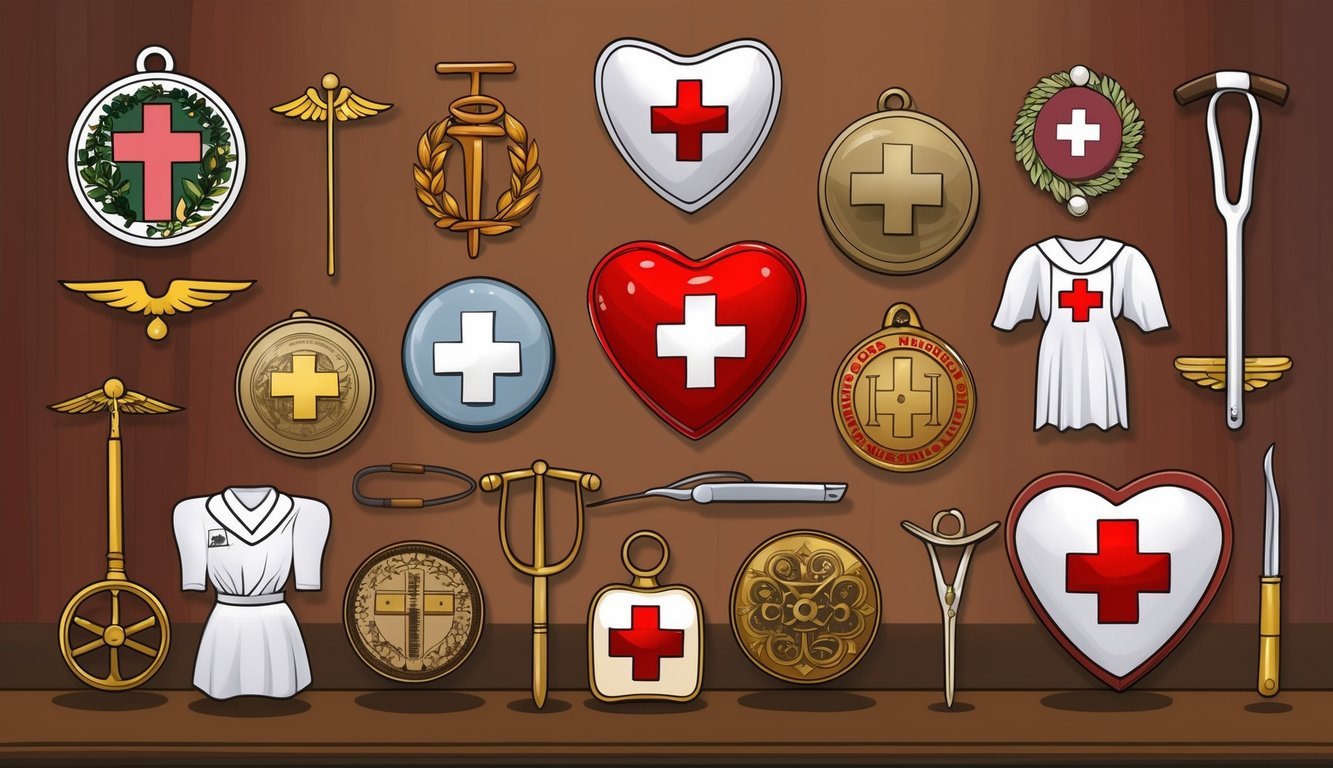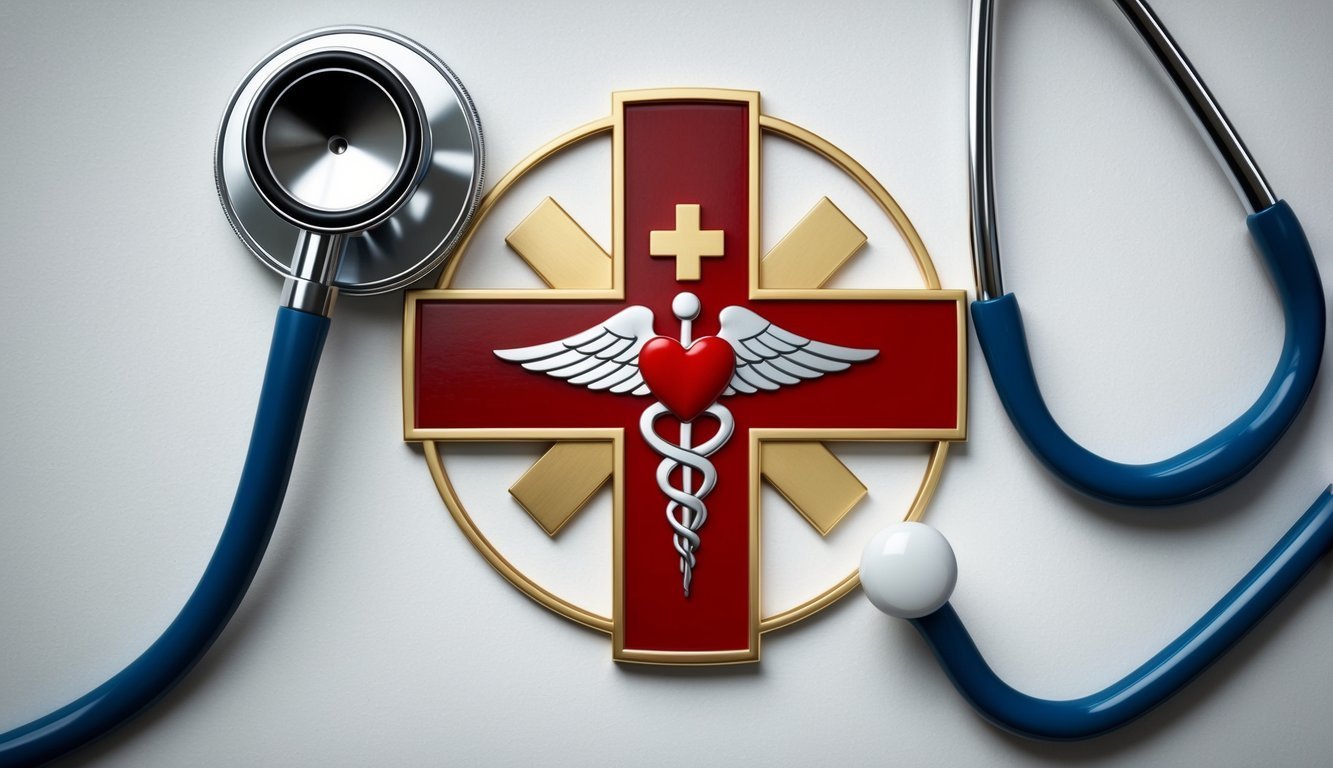Nursing symbols play a vital role in representing the values and history of the nursing profession. These symbols, such as the caduceus and the lamp of knowledge, highlight the dedication and care that nurses bring to healthcare. Understanding these symbols can help you appreciate their significance and the legacy of nursing.
Throughout history, nursing symbols have evolved, reflecting changes in the medical profession and the role of healthcare professionals.
Whether you’re a nursing student or a practicing nurse, knowing the meaning behind these symbols can enhance your professional identity and connection to the field.
As you explore the various symbols associated with nursing, you will uncover valuable insights into the profession and its impact on patient care and education.
The stories behind these symbols show how they inspire commitment and pride among healthcare workers.
Key Takeaways
- Nursing symbols represent the history and values of the nursing profession.
- Understanding these symbols enhances your connection to healthcare.
- Symbols play a significant role in professional identity and recognition.
Historical Evolution of Nursing Symbols

Nursing symbols have deep historical roots and reflect the values and identity of the profession.
These symbols evolved over time, influenced by key individuals and moments in nursing history, shaping what you see today in modern nursing.
Origin of the Nurse Symbol
The origins of nursing symbols can be traced back to ancient civilizations where health and healing were represented through various emblems.
The Rod of Asclepius, featuring a single snake entwined around a staff, symbolizes healing and medicine.
In contrast, the Caduceus has two snakes and is often mistakenly associated with nursing, despite primarily representing commerce.
The symbols grew in significance as nursing emerged as a profession.
The historical nurse cap or nursing cap became an iconic part of a nurse’s uniform in the 19th century, symbolizing her role and commitment.
This headpiece, often white, represented purity and dedication, evolving from practical use into a symbol of service.
Florence Nightingale’s Influence
Florence Nightingale played a crucial role in shaping nursing symbols and the profession itself.
Often referred to as the “Lady with the Lamp,” her commitment to nursing and patient care laid the foundation for modern nursing practices.
The oil lamp she carried during her night rounds became a symbol of hope and compassion.
Nightingale introduced the Nightingale Pledge, which nurses recite to uphold their commitment to ethical care.
This pledge also reflects the nursing values that are still honored today.
As she emphasized education and standards, the nursing emblem began to represent a commitment to professionalism and ethical practice.
Adoption of Symbols in Nursing
As nursing evolved, so did the adoption of various symbols.
The Red Cross symbol emerged in the late 19th century to signify humanitarian efforts, aligning with nursing’s mission to provide care without discrimination.
In addition, nursing pins became a popular way to symbolize achievement and dedication.
These pins often featured the nursing school’s emblem and were presented during graduation ceremonies.
They serve as a reminder of your hard work and the ethical standards you are expected to uphold.
Today, while many modern nurses still recognize symbols like the lamp of knowledge and the Caduceus, knowledge of their historical context enhances appreciation for the nursing profession’s rich heritage.
Understanding these symbols allows you to connect more deeply with the values and traditions of nursing.
Contemporary Symbols of Nursing
Nursing symbols reflect the profession’s values and commitment to care.
This section covers modern nursing attire, the significance of pinning ceremonies, and the role of healthcare symbols in medical jewelry.
Modern Nursing Attire
Today, scrubs are the standard uniform for nurses.
They are functional, easy to clean, and designed for comfort during long shifts.
Scrubs often come in various colors and patterns, which allow some personal expression while promoting a professional image.
In addition to scrubs, nurses might wear lab coats or jackets.
These pieces often symbolize authority and professionalism.
Many facilities also require specific attire, reinforcing a unified team appearance.
Key elements of nursing attire include:
| Element | Purpose |
|---|---|
| Scrubs | Comfortable, easy to clean |
| Lab Coats | Symbolize professionalism and authority |
| Footwear | Supportive shoes for prolonged standing |
| Name Tags | Enhance patient communication and safety |
Pinning Ceremonies and Their Meaning
Pinning ceremonies are a proud tradition in nursing.
They mark the transition from student to professional nurse.
During the ceremony, students receive a special pin symbolizing their achievement.
The pin often features important symbols like the caduceus or the red cross.
These symbols represent healing and the commitment to patient care.
This ceremony emphasizes the deep respect and responsibility associated with the nursing profession.
Attending such a ceremony can be a memorable experience.
It reflects hard work and dedication and often involves family and friends, celebrating a significant milestone in your nursing career.
Healthcare Symbols in Medical Jewelry
Medical jewelry is an important aspect of nurse symbolism.
It often contains symbols like the star of life or other medical icons.
These pieces can carry vital information for emergencies.
Common types of medical jewelry include:
| Type | Description |
|---|---|
| Bracelets | Often engraved with medical conditions |
| Necklaces | Display medical symbols for identification |
| Rings | May identify the wearer as a healthcare professional |
Wearing these items not only reflects your role in healthcare but also can aid in emergency situations, ensuring that medical personnel can quickly access crucial information.
Significance and Misconceptions
Understanding the symbols associated with nursing is essential.
The mix of mythology and practical use has led to various misconceptions about what these symbols truly represent in healthcare today.
Mythology and the Medical Caduceus
The Caduceus is often mistakenly associated with medicine.
In Greek mythology, it was a symbol of commerce and negotiation, linked to Hermes Trismegistus, a messenger of the gods.
The staff features two snakes entwined around it.
Because of its visual appeal, it has been used in medical settings, but it does not represent healing.
Many believe it signifies a commitment to patient care, but its true roots lie in trade, not healthcare.
The Rod of Asclepius in Healthcare
In contrast, the Rod of Asclepius is the correct symbol of healing.
Asclepius was the Greek god of medicine and healing, often depicted with a single snake wrapped around a staff.
This symbol represents not just healing but also rebirth and recovery, making it a true emblem of healthcare.
The Rod of Asclepius is widely accepted as the healthcare symbol and is used by many medical organizations.
Its accurate representation helps convey the true dedication and care from healthcare professionals.
Nurse Symbolism in Popular Culture
Nurse symbolism is prevalent in popular culture, showcasing the vital role nurses play in healthcare.
The lamp of knowledge is a common symbol, representing wisdom and the ongoing quest for learning in nursing.
You may see various nurse symbols in movies, TV shows, and literature reflecting the compassion and dedication found in the nursing profession.
However, these representations can sometimes amplify misconceptions, such as the portrayal of nurses merely as assistants to doctors, overlooking their critical roles in patient care and decision-making.
Nursing Education and Professional Development

Investing in nursing education is key to your growth in the nursing profession.
Understanding the significance of symbols like the Lamp of Life can guide you in your journey.
Through proper education, you can enhance your wisdom and skills, leading to better patient care and professional advancement.
Nursing School and Symbolic Education
In nursing school, the curriculum often includes symbolic education that helps shape your identity as a healthcare provider.
You learn about various symbols, such as the Lamp of Life, which represents wisdom, knowledge, and enlightenment in nursing practice.
This education is crucial for developing a strong foundation in nursing skills.
You engage in hands-on training, simulations, and clinical rotations to experience real-world scenarios.
Being aware of nursing symbols enriches your understanding of the profession and reminds you of the values inherent in your career.
Advancement in Nursing Practice
As you pursue advancement in nursing practice, continuous education becomes essential.
Specialized training and certifications allow you to expand your expertise in areas like pediatrics, oncology, or critical care.
Staying informed about current trends in healthcare helps you provide top-notch patient care.
Professional development also includes attending workshops and conferences.
Networking with other healthcare providers can inspire you and help you learn about new techniques in the field.
By committing to lifelong learning, you ensure that your nursing career evolves alongside advancements in medical corps and healthcare innovations.
This dedication improves your job prospects and increases your ability to impact patient outcomes positively.
Role and Recognition of Nursing Symbols in Healthcare

Nursing symbols play a crucial role in identifying healthcare professionals and conveying their commitment to patient care.
Understanding these symbols helps you appreciate their significance in the medical field and recognizes the shared values among medical personnel.
Symbols as Identification for Medical Personnel
Nursing symbols serve as key identifiers for healthcare professionals.
For instance, the Caduceus and the Rod of Asclepius are widely recognized symbols associated with medicine.
The Caduceus, often linked with nursing, features two snakes entwined around a staff.
In contrast, the Rod of Asclepius has a single snake and symbolizes healing.
These symbols are not just decorative; they represent a commitment to patient wellness and safety.
Many nurses and medical personnel wear badges with these symbols to denote their professional roles.
This visual identification fosters trust between healthcare providers and patients, ensuring that individuals seek out the right professionals for their needs.
International Symbols for Nursing
Different cultures utilize various nursing symbols that transcend borders.
Common symbols you might encounter include the Red Cross, which is internationally recognized as a symbol of medical assistance.
The Star of Life also has global recognition, especially among emergency medical services.
It represents the six functions of prehospital emergency medical services: detection, reporting, response, on-scene care, Care in Transit, and Transfer to Definitive Care.
These symbols hold universal meanings, connecting healthcare professionals and patients around the world.
When you see these symbols, understand that they embody a commitment to health and healing, regardless of geographical boundaries.
They highlight the shared mission of healthcare professionals to provide care and support to those in need.
Frequently Asked Questions

This section answers common questions regarding nursing symbols.
You will learn about their meanings, differences from medical symbols, and the imagery often used in tattoos and emblems.
What does the traditional nursing symbol represent?
The traditional nursing symbol is often represented by the Lamp of Learning, which symbolizes knowledge and enlightenment in nursing.
It honors Florence Nightingale, a pioneer in nursing, who used the lamp to light her way while caring for patients.
How does the nursing symbol differ from the medical symbol?
Nursing symbols focus on care and compassion, while medical symbols, like the Caduceus, emphasize healing and medicine.
The Caduceus features two snakes wrapped around a staff, representing trade and negotiation rather than nursing specifically.
What iconography is typically used in nurse symbol tattoos?
Common tattoo designs for nurses include the Caduceus, the Lamp of Learning, and the Heartbeat line.
These symbols reflect the dedication and passion nurses have for their profession and the care they provide.
What floral emblem is often associated with nursing?
The rosemary plant is often linked to nursing because it symbolizes remembrance and fidelity.
It has historical roots in medicine.
The plant was used for various healing purposes in traditional practices.
Are there distinct emblems for different nursing specialties, such as nurse practitioners?
Yes, there are unique emblems for various nursing specialties.
For example, nurse practitioners often use symbols that include the Caduceus or the Rod of Asclepius to represent their advanced practice in healthcare.
What imagery is commonly used to symbolize the healthcare profession as a whole?
Common imagery for the healthcare profession includes the Red Cross, the Star of Life, and the Rod of Asclepius.
These symbols are recognized widely and represent the commitment to health and healing across the medical field.

